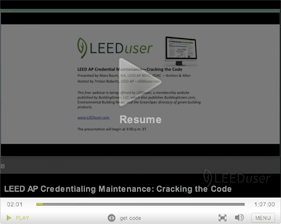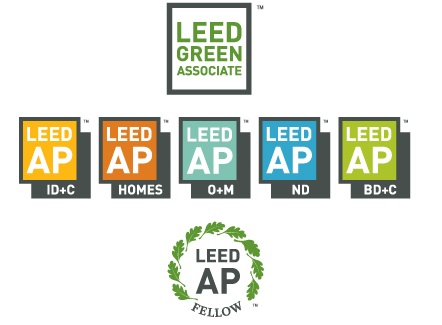Thanks for going over all of this Mara. For some Legacy LEED APs occupations, as you mentioned, especially for entrepreneurs who operate their own businesses, it may not be necessary for to enroll in CMP. Indeed, the prescriptive maintenance requirement is a real pain for independent consultants and entrepreneurs. For people who work for a big firm, where there is pressure to conform with peers who have the "with specialty" title, it may make more sense, not only because, in theory, the company itself is investing its own time and money to maintain the education level of its employees, but also because it's probably a resume enhancement if the employee ever leaves that company. Over time, "with specialty" titles will become more popular, but to the extent that it's a recognizable brand, the term LEED AP will always be at the forefront of people's awareness. - Rob
Blog Post
LEED AP Credential Maintenance: Cracking the Code

I've got questions. Is it worth opting in to the new system of LEED AP + a.k.a. LEED AP "with specialty"? GBCI is allowing legacies to opt into the new system until 2011 without having to take the new exam. If I opt in, how do I satisfy the 30 hours of continuing education requirements I'll be beholden to? Is that something I can do with a mix of presenting, self-study, LEED project work, and Greenbuild attendance, or will I have to seek out additional avenues?
If you're a LEED Green Associate (LEED GA) or already a LEED AP + you might share some of these questions.
The person I've been turning to for help lately is Mara Baum, AIA, LEED AP BD+C, EDAC, of Anshen + Allen. In her words: "When GBCI came out with the new LEED AP credentialing maintenance program last spring, I started to evaluate the program for our firm's 75+ LEED APs. What started as a quick look at GBCI's handbook evolved into a major research project."

I asked Mara to present a webinar on what she's learned for LEEDuser, our how-to website for LEED projects. She obliged on February 23rd, and the recording, which includes over 10 minutes of Q&A from the 200 audience members, is a great resource that we've just posted
I recommend checking it out over on the LEEDuser website (the site is a membership resource, but this page is free).
With my help Mara also took some additional questions in writing after the webinar was over, and these are shown on the LEEDuser page. Here's a couple particularly helpful ones.
SUPPORT INDEPENDENT SUSTAINABILITY REPORTING
BuildingGreen relies on our premium members, not on advertisers. Help make our work possible.
See membership options »Q: Right now I am working on LEED registered project, how can I report those hours into CMP record?Interested in more? Check out the article "Video: LEED AP Credential Maintenance" on LEEDuser. There's also a Q&A forum right there to engage further with the LEEDuser community. Feel free to also comment below!A: Through the self-reporting mechanism on the GBCI website. Once you have opted into the new system, go to the "My Credentials" page, then select "Review/Report CMP Activity." For LEED credit work, document the hours under the category and subcategory closest to the credit topic. The language may not align perfectly, but do the best you can. It's not clear what category to use to document project administrator work. "Stakeholder Involvement In Innovation" and subcategory "Ways to Earn Credit" seems like the closest fit right now.
Q: When does the two-year cycle start? The date I took the LEED AP v2 test and passed?
A: If you are opting in as a "Legacy LEED AP", then the two-year period begins on the day that you opt in to the new system. There is no relationship with the date you took the "old" LEED AP exam. If you are taking the new exam, the cycle starts on the day you pass the exam. If you take the two exams on different dates, then the cycle starts on the day you pass the second exam.
Published March 3, 2010 Permalink Citation
(2010, March 3). LEED AP Credential Maintenance: Cracking the Code. Retrieved from https://www.buildinggreen.com/blog/leed-ap-credential-maintenance-cracking-code
Comments
I suspect that many people wi
I suspect that many people will need to weigh the pros and cons of "opting in" in terms of these questions:
- I don't feel like I need the LEED AP+ credential now, but will I in the future? If yes, how long from now do I think I'll want or need it?
- How much of a pain will the continuing education be? Is it something I can fit into my current professional development habits or opportunities?
- Is it worth the hassle of the CMP (especially the prescriptive requirements of the first cycle) to opt in by fall 2011, or will I want the LEED AP+ so long from now (if ever) that I'll just deal with retesting when the time comes?
For those of you on the fence with these questions, you probably will want to hold off on a decision until fall 2011 -- at that time you'll better understand the continuing education options available, as well as the market demand for the LEED AP+ credential.



Add new comment
To post a comment, you need to register for a BuildingGreen Basic membership (free) or login to your existing profile.